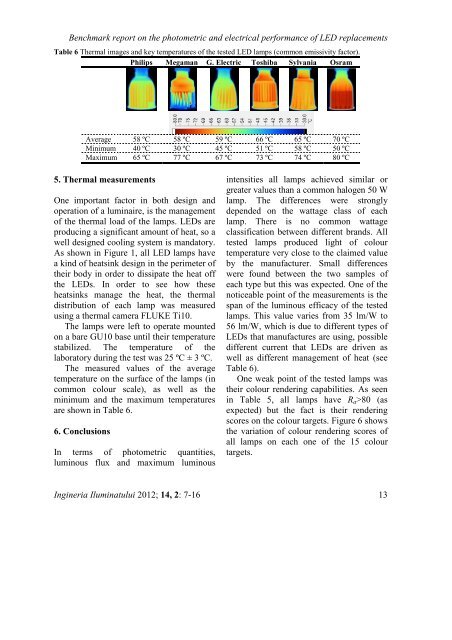Untitled - Journal of Lighting Engineering
Untitled - Journal of Lighting Engineering
Untitled - Journal of Lighting Engineering
You also want an ePaper? Increase the reach of your titles
YUMPU automatically turns print PDFs into web optimized ePapers that Google loves.
Benchmark report on the photometric and electrical performance <strong>of</strong> LED replacements<br />
Table 6 Thermal images and key temperatures <strong>of</strong> the tested LED lamps (common emissivity factor).<br />
Philips Megaman G. Electric Toshiba Sylvania Osram<br />
Average 58 ºC<br />
Minimum 40 ºC<br />
Maximum 65 ºC<br />
5. Thermal measurements<br />
One important factor in both design and<br />
operation <strong>of</strong> a luminaire, is the management<br />
<strong>of</strong> the thermal load <strong>of</strong> the lamps. LEDs are<br />
producing a significant amount <strong>of</strong> heat, so a<br />
well designed cooling system is mandatory.<br />
As shown in Figure 1, all LED lamps have<br />
a kind <strong>of</strong> heatsink design in the perimeter <strong>of</strong><br />
their body in order to dissipate the heat <strong>of</strong>f<br />
the LEDs. In order to see how these<br />
heatsinks manage the heat, the thermal<br />
distribution <strong>of</strong> each lamp was measured<br />
using a thermal camera FLUKE Ti10.<br />
The lamps were left to operate mounted<br />
on a bare GU10 base until their temperature<br />
stabilized. The temperature <strong>of</strong> the<br />
laboratory during the test was 25 ºC ± 3 ºC.<br />
The measured values <strong>of</strong> the average<br />
temperature on the surface <strong>of</strong> the lamps (in<br />
common colour scale), as well as the<br />
minimum and the maximum temperatures<br />
are shown in Table 6.<br />
6. Conclusions<br />
In terms <strong>of</strong> photometric quantities,<br />
luminous flux and maximum luminous<br />
Ingineria Iluminatului 2012; 14, 22:<br />
7-16<br />
58 ºC 59 ºC 66 ºC 65 ºC<br />
30 ºC 45 ºC 51 ºC 58 ºC<br />
77 ºC 67 ºC 73 ºC 74 ºC<br />
70 ºC<br />
50 ºC<br />
80 ºC<br />
intensities all lamps achieved similar or<br />
greater values than a common hhalogen<br />
50 W<br />
lamp. The differences were strongly<br />
depended on the wattage class <strong>of</strong> each<br />
lamp. There is no common wattage<br />
classification between different brands. All<br />
tested lamps produced light <strong>of</strong> colour<br />
temperature very close to the claimed value<br />
by the manufacturer. ufacturer. Small differences<br />
were found between the two samples <strong>of</strong><br />
each type but this was expected. One <strong>of</strong> the<br />
noticeable point <strong>of</strong> the measurements is the<br />
span <strong>of</strong> the luminous efficacy <strong>of</strong> the tested<br />
lamps. This value varies from 35 lm/W to<br />
56 lm/W, which is s due to different types <strong>of</strong><br />
LEDs that manufactures are using, possible<br />
different current that LEDs are driven as<br />
well as different management <strong>of</strong> heat (see<br />
Table 6).<br />
One weak point <strong>of</strong> the tested lamps was<br />
their colour rendering capabilities. As seen<br />
in Table 5, all lamps have Ra>80 (as<br />
expected) but the fact is their rendering<br />
scores on the colour our targets. Fig Figure 6 shows<br />
the variation <strong>of</strong> colour rendering scores <strong>of</strong><br />
all lamps on each one <strong>of</strong> the 15 colour<br />
targets.<br />
13
















